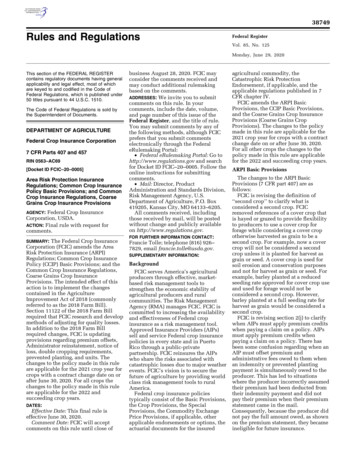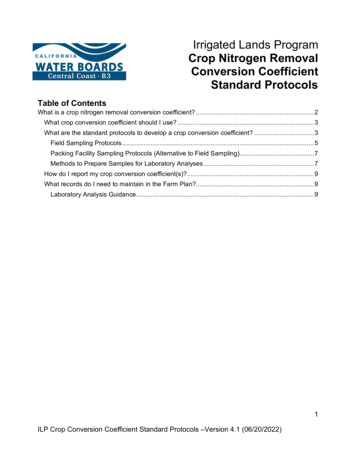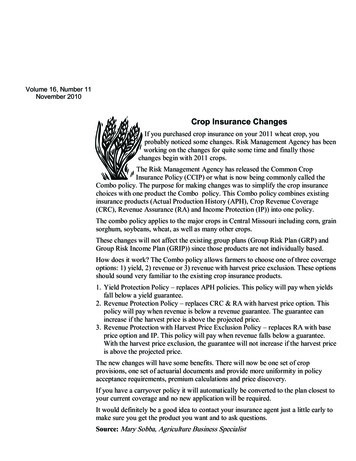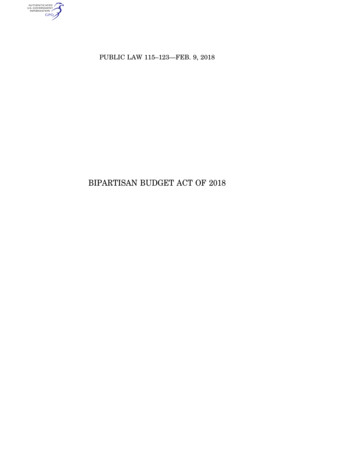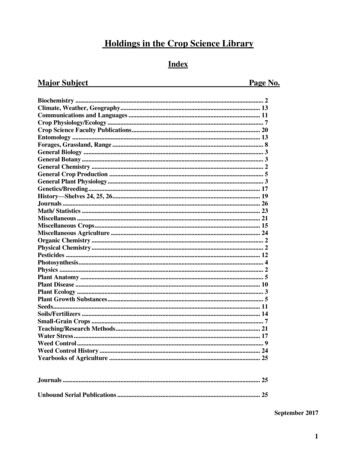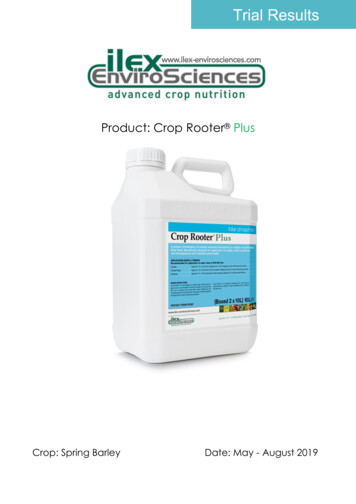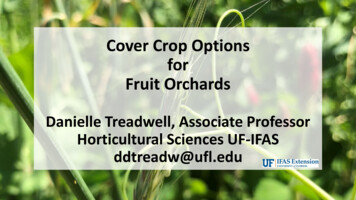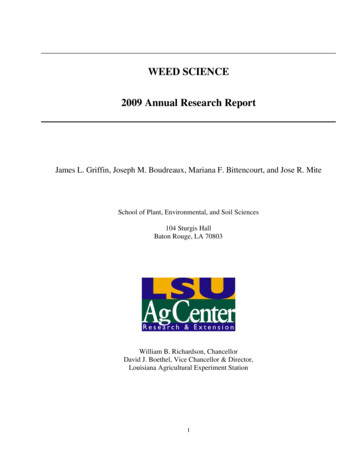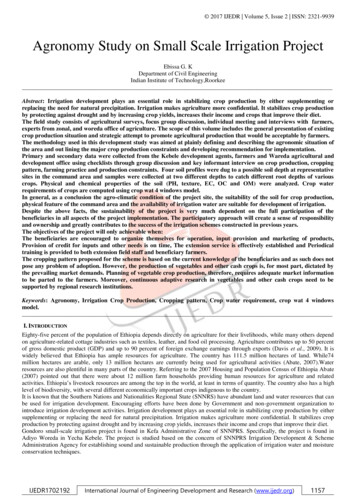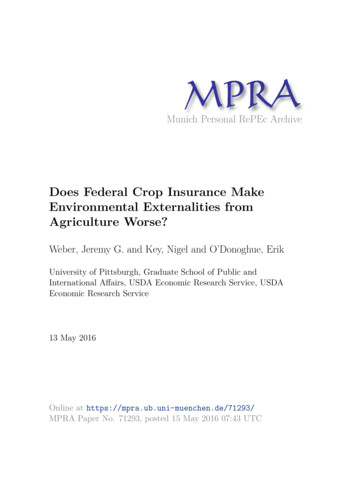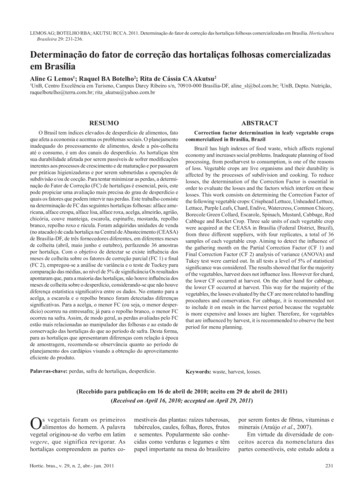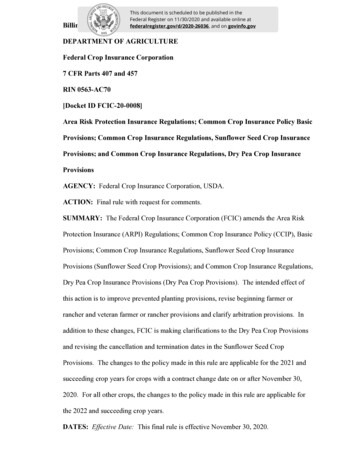
Transcription
Billing CodeThis document is scheduled to be published in theFederal Register on 11/30/2020 and available online at3410-08-Pfederalregister.gov/d/2020-26036, and on govinfo.govDEPARTMENT OF AGRICULTUREFederal Crop Insurance Corporation7 CFR Parts 407 and 457RIN 0563-AC70[Docket ID FCIC-20-0008]Area Risk Protection Insurance Regulations; Common Crop Insurance Policy BasicProvisions; Common Crop Insurance Regulations, Sunflower Seed Crop InsuranceProvisions; and Common Crop Insurance Regulations, Dry Pea Crop InsuranceProvisionsAGENCY: Federal Crop Insurance Corporation, USDA.ACTION: Final rule with request for comments.SUMMARY: The Federal Crop Insurance Corporation (FCIC) amends the Area RiskProtection Insurance (ARPI) Regulations; Common Crop Insurance Policy (CCIP), BasicProvisions; Common Crop Insurance Regulations, Sunflower Seed Crop InsuranceProvisions (Sunflower Seed Crop Provisions); and Common Crop Insurance Regulations,Dry Pea Crop Insurance Provisions (Dry Pea Crop Provisions). The intended effect ofthis action is to improve prevented planting provisions, revise beginning farmer orrancher and veteran farmer or rancher provisions and clarify arbitration provisions. Inaddition to these changes, FCIC is making clarifications to the Dry Pea Crop Provisionsand revising the cancellation and termination dates in the Sunflower Seed CropProvisions. The changes to the policy made in this rule are applicable for the 2021 andsucceeding crop years for crops with a contract change date on or after November 30,2020. For all other crops, the changes to the policy made in this rule are applicable forthe 2022 and succeeding crop years.DATES: Effective Date: This final rule is effective November 30, 2020.
Comment Date: We will consider comments that we receive by the close of business[Insert date 60 days after publication in the FEDERAL REGISTER]. FCIC mayconsider the comments received and may conduct additional rulemaking based on thecomments.ADDRESSES: We invite you to submit comments on this rule. You may submitcomments by either of the following methods, although FCIC prefers that you submitcomments electronically through the Federal eRulemaking Portal: Federal eRulemaking Portal: Go tohttps:/www.regulations.gov/docket?D FCIC-20-0008 and follow theinstructions for submitting comments. Mail: Director, Product Administration and Standards Division, RiskManagement Agency, US Department of Agriculture, P.O. Box 419205,Kansas City, MO 64133-6205. In your comment, specify docket IDFCIC-20-0008.Comments will be available for viewing online at www.regulations.gov. Commentsreceived will be posted without change, including any personal information provided. Inaddition, comments will be available for public inspection at the above address duringbusiness hours from 8 a.m. to 5 p.m., Monday through Friday, except holidays.FOR FURTHER INFORMATION CONTACT: Francie Tolle; telephone (816) 926–7829; or email francie.tolle@usda.gov.SUPPLEMENTARY INFORMATION:BackgroundFCIC serves America’s agricultural producers through effective, market-basedrisk management tools to strengthen the economic stability of agricultural producers andrural communities. The Risk Management Agency (RMA) administers the FCICregulations. FCIC is committed to increasing the availability and effectiveness of Federal
crop insurance as a risk management tool. Approved Insurance Providers (AIPs) sell andservice Federal crop insurance policies in every state and in Puerto Rico through a publicprivate partnership. FCIC reinsures the AIPs who share the risk associated withcatastrophic losses due to major weather events. FCIC’s vision is to secure the future ofagriculture by providing world class risk management tools to rural America.Federal crop insurance policies typically consist of the Basic Provisions, the CropProvisions, the Special Provisions, the Commodity Exchange Price Provisions, ifapplicable, other applicable endorsements or options, the actuarial documents for theinsured agricultural commodity, the Catastrophic Risk Protection Endorsement, ifapplicable, and the applicable regulations published in 7 CFR chapter IV.FCIC amends the ARPI Basic Provisions, the CCIP Basic Provisions, theSunflower Seed Crop Provisions, and the Dry Pea Crop Provisions. The changes to thepolicy made in this rule are applicable for the 2021 and succeeding crop years for cropswith a contract change date on or after November 30, 2020. For all other crops thechanges to the policy made in this rule are applicable for the 2022 and succeeding cropyears.ARPI Basic ProvisionsThe changes to the ARPI Basic Provisions (7 CFR part 407) are:FCIC is revising sections 23(d)(1), (2), and (5)(i) of the ARPI Basic Provisions toclarify the responsibility is on the producer to start dispute resolution through arbitrationwhen the producer disagrees with an AIP determination. There has been confusion thatthis provision could require both the producer and the AIP to start arbitration prior tolitigation.FCIC is also making non-substantive changes to the regulation. Examples includemaking references consistent, making grammatical corrections, and clarifying word
changes. These revisions are editorial in nature and are intended to provide clarity to theregulation.CCIP Basic ProvisionsThe changes to the CCIP Basic Provisions (7 CFR part 457.8) are:FCIC is revising section 3(l) to allow a producer that qualifies as a beginningfarmer or rancher (BFR), or veteran farmer or rancher (VFR), to receive a yield based onthe actual production history (APH) of the previous producer of the crop or livestock onthe acreage, if the BFR or VFR was previously involved in the decision-making orphysical activities of the crop or livestock on any farm. Previously, the provisionsspecified that the APH history of the acreage could only be used if the BFR or VFR waspreviously involved on the specific acreage acquired.Prevented planting is a feature of many crop insurance plans that provides apartial payment to cover certain pre-plant costs for a crop that was prevented from beingplanted due to an insurable cause of loss. After unprecedented prevented planting in2019, FCIC examined how to improve the prevented planting coverage within a policy.FCIC held discussions with stakeholders via a Prevented Planting Taskforce that includedFCIC and industry representatives. The taskforce reviewed the previous policy,discussed impacts, and explored policy improvements. The goal of the taskforce was toimprove coverage for producers when needed most, but not replace market incentiveswith government incentives, while maintaining program integrity. The taskforceidentified several issues that are extremely uncommon but could occur in years whenprevented planting is catastrophic and widespread. The following lists the changes insection 17 of the CCIP Basic Provisions:FCIC is revising section 17(e)(1)(i) to add a reference to the new provisions insection 17(e)(1)(ii)(E).FCIC is revising section 17(e)(1)(ii) to allow the use of an intended acreage report
for the first 2 consecutive crop years the producer farms in a new county, instead of onlythe first year.The CCIP Basic Provisions define “intended acreage report” as a report of theacreage a producer intends to plant, by crop, for the current crop year and used solely forthe purpose of establishing eligible prevented planting acreage, as required in section 17.Further, section 17 states that if the insured did not plant any crop in the county for whichprevented planting coverage was available in the 4 most recent crop years, the producermust complete and submit an intended acreage report to the AIP by the sales closing date,or within 10 days of land acquisition after the sales closing date, to establish the potentialmaximum number of eligible prevented planting acres.Based on the previous provision, when a producer adds new land in a new county,the producer could only indicate intended acres for the first year. An issue arises in thesecond year if the producer, following good farming practices for crop rotation, intends toplant a different crop. Because the producer only has 1 year of history in the county, theproducer is limited in the amount of acreage (and type of crop) that can be claimed forprevented planting purposes.For example, a producer adds land in a new county. The first year, the producerfiles an intended acreage report for wheat and plants the entire acreage to wheat. Thesecond year, the producer intends to plant corn, but is prevented from planting due to aninsurable cause of loss. Under the previous regulations, the producer would not have anyeligible prevented planting acreage for corn because they only have eligible wheat acresbased on their first year’s history in their APH database. The producer would receive aprevented planting payment based on the eligible wheat acres. This would result in adifferent prevented planting payment than the intended corn crop, which may not bereflective of their pre-plant costs.As specified above, FCIC will revise section 17(e)(1)(ii) to allow the producer to
submit an intended acreage report for the first 2 consecutive crop years the producerfarms in a new county. In the above scenario, this will allow the producer to receive aprevented planting payment based on the acres contained on the intended acreage reportfor the second year and the payment will be based on corn. This change acknowledgesrotational practices are a good farming practice. It will also result in more accurateprevented planting payments because they will be based on the producer’s actualintended plantings for that year.FCIC is revising section 17(e)(2) to provide that if following a failed first insuredcrop, an uninsured second crop is planted on the same acres within the same crop year,the planted acres of the uninsured crop will not be subtracted from the eligible preventedplanting acreage.Section 17(e)(2) of the CCIP Basic Provisions previously stated, “Any eligibleacreage determined in accordance with section 17(e)(1) will be reduced by subtractingthe number of acres of the crop (insured and uninsured) that are timely and late planted,including acreage specified in section 16(b).” If following a failed first insured crop, theproducer plants an uninsured second crop on the same acres within the same crop year;acres from both plantings (first insured crop and second uninsured crop) are subtractedfrom the eligible prevented planting acreage, even though it is the same physical landsubtracted twice. On occasion, this can lead to the producer having acres that do notreceive a prevented planting payment due to inadequate eligible prevented planting acres.This occurrence is extremely rare, but it affected a small number of producers in the 2019crop year. To illustrate the rarity of these circumstances, for the reduction to apply underthe previous regulation, all of the following must have been true for the producer:1) Planted a first crop that fails,2) Planted a second crop on the same acreage following the failed crop, and3) Exhausted eligible prevented planting acres available to pay a claim.
The underlying concern is that the same physical acres are subtracted twice fromoverall prevented planting eligible acres. To illustrate the inequity of the doublesubtraction, the following is a simple example of the previous provisions. A producer has100 total acres of cropland (fields A & B) and intends to plant all 100 acres to corn.Based on production history, the producer also has 100 prevented planting eligible acres(50 for corn and 50 for soybeans). The producer plants 50 acres of corn in field A,resulting in 50 corn acres subtracted from eligible prevented planting acres. At this point,there are 50 soybean eligible prevented planting acres and zero corn eligible preventedplanting acres. A flood destroys the 50 acres of corn in field A, the AIP determines it isnot practical to replant, and the producer does not have to replant to retain insurance. Theproducer files a claim for indemnity for the crop loss and receives an indemnity for thefield A 50 destroyed corn acres. Later, the producer plants the 50 acres in field A tosoybeans that are not insured. The second planting of field A (uninsured soybeans)would result in the subtraction of 50 acres of eligible prevented planting acres ofsoybeans. This equates to 100 eligible prevented planting acres being subtracted from thesame 50 physical acres (field A); leaving 0 eligible prevented planting acres remainingfor the 50 physical acres prevented from planting in field B that remains unplanted.FCIC is removing the double subtraction on field A by no longer subtracting theuninsured second planting from eligible prevented planting acres. This would allow aprevented planting payment on field B, if those acres were unable to be planted, and ifother policy provisions for prevented planting claims are met.To illustrate the inequity of the previous provisions in a different way, see thefollowing scenarios below. These scenarios show the disparate treatment of twoproducers in the same situation, except that their 100 prevented planting eligible acres arefor different crops. Scenario 1: Producer has 100 acres of corn prevented plantingeligible acres and 0 acres of soybean prevented planting eligibility. There is no impact on
prevented planting eligibility for field B. Since there are 0 acres of soybean eligibleprevented planting acres, the 50 planted acres of uninsured soybeans (field A) would notbe subtracted from prevented planting eligibility. In this case, the producer would remaineligible for a prevented planting payment on the 50 acres of corn (field B) that wereprevented from being planted.CropPlanted (insuredPreventedAvailable for& uninsured)from Planting PaymentEligible AcresCorn10050505005000SoybeansScenario 2: A producer has 50 acres of prevented planting corn eligibility and 50acres of prevented planting soybean eligibility; prevented planting eligibility iseliminated on field B. Previously, prevented planting eligible acres are reduced byplanted acres of insured and uninsured crops, and the 50 acres of planted and then failedcorn in field A would exhaust corn prevented planting eligibility. The planting of 50acres of uninsured soybeans in field A would exhaust the soybean prevented plantingeligibility as well. There would be no remaining eligible prevented planting acres for the50 acres of corn prevented from being planted in field B.CropPlanted (insuredPreventedAvailable for& uninsured)from PlantingPaymentEligible AcresCorn5050500Soybeans505000Regulation change: For this example, the change to the regulation results inScenario 2 having the same result as Scenario 1 with 50 eligible acres of preventedplanting soybeans which can be used to make the corn payment claimed. Changing thisto not subtract the uninsured acres of soybeans planted on field A will be a more
equitable treatment of producers under catastrophic loss lable forAcres(insured)(uninsured)from PlantingPaymentCorn50500500Soybeans50050050FCIC is revising section 17(f)(1) to provide an exception if the producer canprove intent to plant based on inputs applied or available to apply, rotation, etc., theproducer could then be paid a prevented planting payment based on their intended crop,even if it’s different than the crop that was planted in the field.Previously, section 17(f)(1) of the CCIP Basic Provisions stated, “Any preventedplanting acreage within a field that contains planted acreage will be considered to beacreage of the same crop, type, and practice that is planted in the field.”.For example, a producer intends to plant a 100-acre field to corn, but it is too wetprior to the final plant date. Prior to the end of the late planting period for corn, shebegins planting the field to soybeans. She planted 20 acres of soybeans before gettingrained out. The producer submits a claim for the remaining 80 acres as preventedplanting corn. The producer does not have history of producing both corn and soybeansin the same field in the same crop year. Prevented planting is common to the area and theproducer has adequate corn prevented planting eligible acres to cover the 80 acresprevented from planting.As a result, the producer has receipts for seed and other inputs to prove intent toplant corn. She expects to be paid prevented planting for corn at a higher per acreamount on 80 acres. However, because she planted 20 acres of soybeans in the samefield as her prevented planting claim, section 17(f)(1) requires the 80 acres to beconsidered soybeans and be paid at a lower per acre amount. The previous provision may
have incentivized the producer to not plant soybeans in order to maintain the higherprevented planting payment on corn. Revising the provision could reduce preventedplanting payments when this situation arises in the future.With the revisions to section 17(f)(1) to provide an exception if the producer canprove intent to plant by inputs applied or available to apply, rotation, etc., in the example,the producer could provide documentation that fertilizer application, seed purchases,historical crop rotation patterns, etc. were consistent with intentions to plant corn. Theproducer could then be paid using available corn prevented planting acres, rather thanhaving to consider the prevented planting acres soybeans.FCIC is adding a new section 17(f)(5)(iii) to clarify prevented planting coveragewill not be provided if the act of haying or grazing a cover crop contributed to theacreage being prevented from planting or the cover crop was otherwise harvested prior tothe end of the late planting period. In a previous final rule, section 17(f)(5)(ii) wasrevised to remove the words “or cover” following the word “volunteer,”. In addition,FCIC removed a Special Provisions statement that read: “In lieu of Section 17(f)(5)(ii) ofthe Common Crop Insurance Basic Provisions, haying or grazing a cover crop will notimpact eligibility for a prevented planting payment provided such action did notcontribute to the acreage being prevented from planting.” FCIC received commentsregarding concerns this change could lead to misunderstanding and unforeseenconsequences. Some may interpret this to mean that a cover crop could be hayed orgrazed even if the act contributed to the acreage being prevented from planting or that acover crop could be otherwise harvested prior to the end of the late planting period.Therefore, the additional language incorporates the previous Special Provisionsstatements.FCIC is revising section 17(f)(8) to implement the “1 in 4” requirementnationwide (beyond just the Prairie Pothole National Priority Area discussed below).
Acreage must be physically available for planting to be eligible for a prevented plantingpayment. The “1 in 4” requirement is contained in a Special Provisions statement and isan extension of the CCIP Basic Provisions that the acreage must be physically availablefor planting. The “1 in 4” requirement states that the acreage must have been planted to acrop, insured, and harvested (or if not harvested, adjusted for claim purposes due to aninsurable cause of loss) in at least 1 out of the previous 4 crop years.The “1 in 4” requirement has been in place since the 2012 crop year in the PrairiePothole National Priority Area, which encompasses the states of Iowa, Minnesota,Montana, North Dakota, and South Dakota. The requirement in that area addressedprevented planting payments that were repeatedly made on acreage not physicallyavailable for planting (that is, acreage that is perpetually wet, such as potholes). Addingthe language to the CCIP Basic Provisions for national applicability will allow for equaltreatment for all areas of the United States and further mitigate waste, fraud and abuse forall acreage that is not physically available for planting to a crop to be insured. TheSpecial Provisions statement had a requirement that the acreage must have beenharvested, or if not harvested, was adjusted for claim purposes under the authority of theAct due to an insured cause of loss (other than a cause of loss related to flood or excessmoisture). FCIC identified perpetual drought conditions as a vulnerability and receivedrequests to expand the “1 in 4” requirement in previous years. Therefore, FCIC addedthat in order to meet the “1 in 4” requirement, claim purposes could not be “due todrought” to address prevented planting payments that were repeatedly made on acreagenot physically available for planting on perpetually dry acreage when a crop was notharvested. This incorporates provisions from a Special Provisions statement and as aresult, the Special Provisions statement is removed.FCIC is revising section 20(a) and 20(b)(1) to clarify the responsibility is on theproducer to start dispute resolution through arbitration when the producer disagrees with
an AIP determination. The AIP is the only party that makes a determination so theproducer is the only party to the contract that could disagree with the determination theAIP made. There has been confusion that this provision could require both the producerand the AIP to start arbitration prior to litigation.FCIC is also making non-substantive changes to the regulation. Examples includemaking references consistent, making grammatical corrections, and clarifying wordchanges. These revisions are editorial in nature and are intended to provide clarity to theregulation.Sunflower Seed Crop Insurance ProvisionsFCIC is revising section 4 of the Sunflower Seed Crop Insurance Provisions (7CFR part 457.108) to change the cancellation and termination dates in 4 Texas countiesfrom March 15 to January 31 to align with the January 31 sales closing date in thesecounties. This change is being made after a data mining exercise where FCIC identifiedthat the sales closing date and cancellation/termination date did not match in these 4counties.FCIC is also making non-substantive changes to the regulation, includingremoving commas and correcting a spelling error.Dry Pea Crop Insurance ProvisionsFCIC is making non-substantive changes in the Dry Pea Crop InsuranceProvisions (7 CFR part 457.140). Examples include making technical corrections andclarifying language changes. Changes were made to the Dry Pea Crop InsuranceProvisions in a Final rule with request for comments, published in the Federal Register onJune 26, 2020 (85 FR 38276). In reviewing the changes made, FCIC found some of thechanges described in that rule were not made in the Code of Federal Regulations.Additionally, FCIC received comments to that final rule and is making revisions that areeditorial in nature are intended to provide clarity to the regulation. There are other
comments that FCIC received in response to the final rule published June 26, 2020, thatFCIC is continuing to review.Effective Date and Notice and CommentThe Administrative Procedure Act (APA, 5 U.S.C. 553) provides that the noticeand comment and 30-day delay in the effective date provisions do not apply when therule involves specified actions, including matters relating to contracts. This rule governscontracts for crop insurance policies and therefore falls within that exemption. Althoughnot required by APA or any other law, FCIC has chosen to request comments on this rule.For major rules, the Congressional Review Act requires a delay to the effectivedate of 60 days after publication to allow for Congressional review. This rule is not amajor rule under the Congressional Review Act, as defined by 5 U.S.C. 804(2).Therefore, this final rule is effective November 30, 2020.Executive Orders 12866, 13563, 13771 and 13777Executive Order 12866, “Regulatory Planning and Review,” and Executive Order13563, “Improving Regulation and Regulatory Review,” direct agencies to assess allcosts and benefits of available regulatory alternatives, and if regulation is necessary, toselect regulatory approaches that maximize net benefits (including potential economic,environmental, public health and safety effects, distributive impacts, and equity).Executive Order 13563 emphasized the importance of quantifying both costs andbenefits, of reducing costs, of harmonizing rules, and of promoting flexibility. ExecutiveOrder 13777, “Enforcing the Regulatory Reform Agenda,” established a federal policy toalleviate unnecessary regulatory burdens on the American people.The Office of Management and Budget (OMB) designated this rule as notsignificant under Executive Order 12866, “Regulatory Planning and Review,” andtherefore, OMB has not reviewed this rule and analysis of the costs and benefits is notrequired under either Executive Order 12866 or 13563.
Executive Order 13771, “Reducing Regulation and Controlling RegulatoryCosts,” requires that in order to manage the private costs required to comply with Federalregulations that for every new significant or economically significant regulation issued,the new costs must be offset by savings from deregulatory actions. As this rule isdesignated as not significant, it is not subject to Executive Order 13771. In a generalresponse to the requirements of Executive Order 13777, USDA created a RegulatoryReform Task Force, and USDA agencies were directed to remove barriers, reduceburdens, and provide better customer service both as part of the regulatory reform ofexisting regulations and as an ongoing approach. FCIC reviewed this regulation andmade changes to improve any provision that was determined to be outdated, unnecessary,or ineffective.Clarity of the RegulationExecutive Order 12866, as supplemented by Executive Order 13563, requireseach agency to write all rules in plain language. In addition to your substantivecomments on this rule, we invite your comments on how to make the rule easier tounderstand. For example: Are the requirements in the rule clearly stated? Are the scope and intentof the rule clear? Does the rule contain technical language or jargon that is not clear? Is the material logically organized? Would changing the grouping or order of sections or adding headingsmake the rule easier to understand? Could we improve clarity by adding tables, lists, or diagrams? Would more, but shorter, sections be better? Are there specific sectionsthat are too long or confusing? What else could we do to make the rule easier to understand?
Regulatory Flexibility ActThe Regulatory Flexibility Act (5 U.S.C. 601-612), as amended by SBREFA,generally requires an agency to prepare a regulatory analysis of any rule whenever anagency is required by APA or any other law to publish a proposed rule, unless the agencycertifies that the rule will not have a significant economic impact on a substantial numberof small entities. This rule is not subject to the Regulatory Flexibility Act because asnoted above, this rule is exempt from APA and no other law requires that a proposed rulebe published for this rulemaking initiative.Environmental ReviewIn general, the environmental impacts of rules are to be considered in a mannerconsistent with the provisions of the National Environmental Policy Act (NEPA, 42U.S.C. 4321-4347) and the regulations of the Council on Environmental Quality (40 CFRparts 1500-1508). FCIC conducts programs and activities that have been determined tohave no individual or cumulative effect on the human environment. As specified in 7CFR 1b.4, FCIC is categorically excluded from the preparation of an EnvironmentalAnalysis or Environmental Impact Statement unless the FCIC Manager (agency head)determines that an action may have a significant environmental effect. The FCICManager has determined this rule will not have a significant environmental effect.Therefore, FCIC will not prepare an environmental assessment or environmental impactstatement for this action and this rule serves as documentation of the programmaticenvironmental compliance decision.Executive Order 12372Executive Order 12372, “Intergovernmental Review of Federal Programs,”requires consultation with State and local officials that would be directly affected byproposed Federal financial assistance. The objectives of the Executive Order are to fosteran intergovernmental partnership and a strengthened Federalism, by relying on State and
local processes for State and local government coordination and review of proposedFederal financial assistance and direct Federal development. For reasons specified in thefinal rule related notice regarding 7 CFR part 3015, subpart V (48 FR 29115, June 24,1983), the programs and activities in this rule are excluded from the scope of ExecutiveOrder 12372.Executive Order 12988This rule has been reviewed under Executive Order 12988, “Civil JusticeReform.” This rule will not preempt State or local laws, regulations, or policies unlessthey represent an irreconcilable conflict with this rule. Before any judicial actions maybe brought regarding the provisions of this rule, the administrative appeal provisions of 7CFR part 11 are to be exhausted.Executive Order 13132This rule has been reviewed under Executive Order 13132, “Federalism.” Thepolicies contained in this rule do not have any substantial direct effect on States, on therelationship between the Federal government and the States, or on the distribution ofpower and responsibilities among the various levels of government, except as required bylaw. Nor does this rule impose substantial direct compliance costs on State and localgovernments. Therefore, consultation with the States is not required.Executive Order 13175This rule has been reviewed in accordance with the requirements of ExecutiveOrder 13175, “Consultation and Coordination with Indian TribalGovernments.” Executive Order 13175 requires Federal agencies to consult andcoordinate with Tribes on a government-to-government basis on policies that have Tribalimplications, including regulations, legislative comments
Federal Crop Insurance Corporation 7 CFR Parts 407 and 457 RIN 0563-AC70 [Docket ID FCIC-20-0008] Area Risk Protection Insurance Regulations; Common Crop Insurance Policy Basic . The CCIP Basic Provisions define "intended acreage report" as a report of the acreage a producer intends to plant, by crop, for the current crop year and used .
